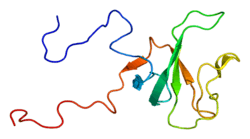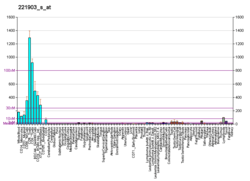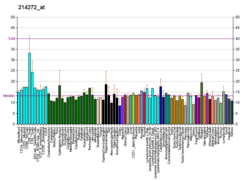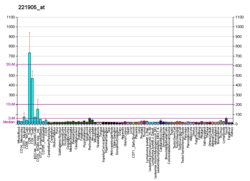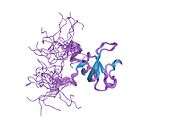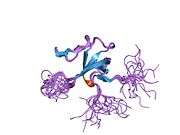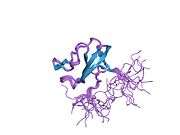CYLD (gene)
Cylindromatosis (turban tumor syndrome), also known as CYLD, is a human gene.[5]
This gene encodes a cytoplasmic protein with three cytoskeletal-associated protein-glycine-conserved (CAP-GLY) domains that functions as a deubiquitinating enzyme. Mutations in this gene have been associated with cylindromatosis, multiple familial trichoepithelioma, and Brooke–Spiegler syndrome. Alternate transcriptional splice variants, encoding different isoforms, have been characterized.[5]
References
External links
- Human CYLD genome location and CYLD gene details page in the UCSC Genome Browser.
Further reading
- Nakajima D, Okazaki N, Yamakawa H, et al. (2003). "Construction of expression-ready cDNA clones for KIAA genes: manual curation of 330 KIAA cDNA clones". DNA Res. 9 (3): 99–106. doi:10.1093/dnares/9.3.99. PMID 12168954.
- Lian F, Cockerell CJ (2006). "Cutaneous appendage tumors: familial cylindromatosis and associated tumors update". Advances in dermatology. 21: 217–34. doi:10.1016/j.yadr.2005.06.005. PMID 16350444.
- Biggs PJ, Wooster R, Ford D, et al. (1996). "Familial cylindromatosis (turban tumour syndrome) gene localised to chromosome 16q12-q13: evidence for its role as a tumour suppressor gene". Nat. Genet. 11 (4): 441–3. doi:10.1038/ng1295-441. PMID 7493027.
- Maruyama K, Sugano S (1994). "Oligo-capping: a simple method to replace the cap structure of eukaryotic mRNAs with oligoribonucleotides". Gene. 138 (1–2): 171–4. doi:10.1016/0378-1119(94)90802-8. PMID 8125298.
- Biggs PJ, Chapman P, Lakhani SR, et al. (1996). "The cylindromatosis gene (cyld1) on chromosome 16q may be the only tumour suppressor gene involved in the development of cylindromas". Oncogene. 12 (6): 1375–7. PMID 8649842.
- Suzuki Y, Yoshitomo-Nakagawa K, Maruyama K, et al. (1997). "Construction and characterization of a full length-enriched and a 5'-end-enriched cDNA library". Gene. 200 (1–2): 149–56. doi:10.1016/S0378-1119(97)00411-3. PMID 9373149.
- Nagase T, Ishikawa K, Suyama M, et al. (1999). "Prediction of the coding sequences of unidentified human genes. XII. The complete sequences of 100 new cDNA clones from brain which code for large proteins in vitro". DNA Res. 5 (6): 355–64. doi:10.1093/dnares/5.6.355. PMID 10048485.
- Thomson SA, Rasmussen SA, Zhang J, Wallace MR (1999). "A new hereditary cylindromatosis family associated with CYLD1 on chromosome 16". Hum. Genet. 105 (1–2): 171–3. doi:10.1007/s004390051083. PMID 10480375.
- Bignell GR, Warren W, Seal S, et al. (2000). "Identification of the familial cylindromatosis tumour-suppressor gene". Nat. Genet. 25 (2): 160–5. doi:10.1038/76006. PMID 10835629.
- Zhang QH, Ye M, Wu XY, et al. (2001). "Cloning and functional analysis of cDNAs with open reading frames for 300 previously undefined genes expressed in CD34+ hematopoietic stem/progenitor cells". Genome Res. 10 (10): 1546–60. doi:10.1101/gr.140200. PMC 310934. PMID 11042152.
- Strausberg RL, Feingold EA, Grouse LH, et al. (2003). "Generation and initial analysis of more than 15,000 full-length human and mouse cDNA sequences". Proc. Natl. Acad. Sci. U.S.A. 99 (26): 16899–903. doi:10.1073/pnas.242603899. PMC 139241. PMID 12477932.
- Trompouki E, Hatzivassiliou E, Tsichritzis T, et al. (2003). "CYLD is a deubiquitinating enzyme that negatively regulates NF-kappaB activation by TNFR family members". Nature. 424 (6950): 793–6. doi:10.1038/nature01803. PMID 12917689.
- Brummelkamp TR, Nijman SM, Dirac AM, Bernards R (2003). "Loss of the cylindromatosis tumour suppressor inhibits apoptosis by activating NF-kappaB". Nature. 424 (6950): 797–801. doi:10.1038/nature01811. PMID 12917690.
- Kovalenko A, Chable-Bessia C, Cantarella G, et al. (2003). "The tumour suppressor CYLD negatively regulates NF-kappaB signalling by deubiquitination". Nature. 424 (6950): 801–5. doi:10.1038/nature01802. PMID 12917691.
- Hu G, Onder M, Gill M, et al. (2003). "A novel missense mutation in CYLD in a family with Brooke-Spiegler syndrome". J. Invest. Dermatol. 121 (4): 732–4. doi:10.1046/j.1523-1747.2003.12514.x. PMID 14632188.
- Regamey A, Hohl D, Liu JW, et al. (2004). "The tumor suppressor CYLD interacts with TRIP and regulates negatively nuclear factor kappaB activation by tumor necrosis factor". J. Exp. Med. 198 (12): 1959–64. doi:10.1084/jem.20031187. PMC 2194148. PMID 14676304.
- Ota T, Suzuki Y, Nishikawa T, et al. (2004). "Complete sequencing and characterization of 21,243 full-length human cDNAs". Nat. Genet. 36 (1): 40–5. doi:10.1038/ng1285. PMID 14702039.
- Zhang XJ, Liang YH, He PP, et al. (2004). "Identification of the cylindromatosis tumor-suppressor gene responsible for multiple familial trichoepithelioma". J. Invest. Dermatol. 122 (3): 658–64. doi:10.1111/j.0022-202X.2004.22321.x. PMID 15086550.
- Jono H, Lim JH, Chen LF, et al. (2004). "NF-kappaB is essential for induction of CYLD, the negative regulator of NF-kappaB: evidence for a novel inducible autoregulatory feedback pathway". J. Biol. Chem. 279 (35): 36171–4. doi:10.1074/jbc.M406638200. PMID 15226292.
This article is issued from
Wikipedia.
The text is licensed under Creative Commons - Attribution - Sharealike.
Additional terms may apply for the media files.
